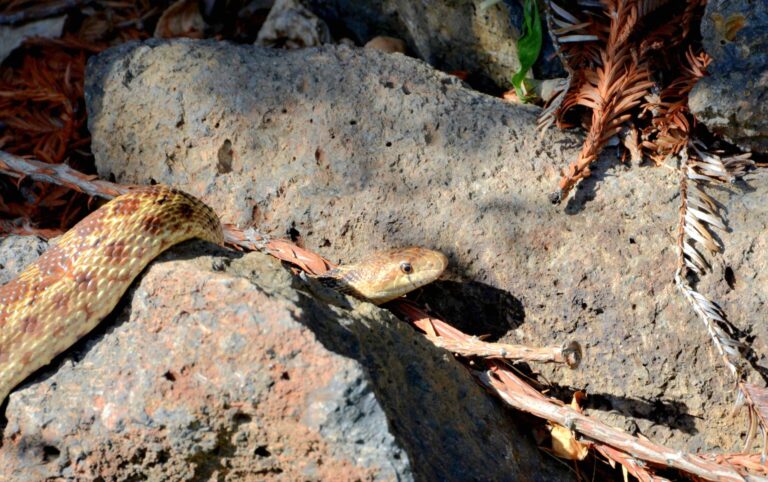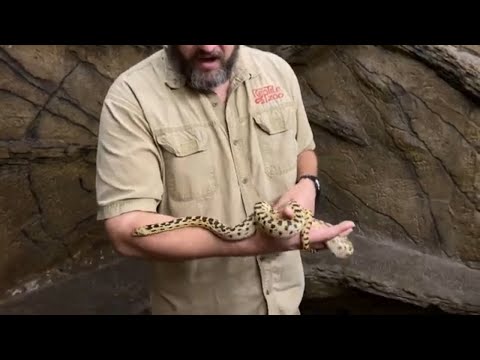You are wise to be cautious when dealing with any snake out in the wilderness, but the similarities between various species, including venomous and non-venomous ones, make the matter of positive identification anything but easy.

Confusing a harmless snake for a dangerous one can lead to panic and fear for nothing, and the opposite might lead to disaster!
Let’s look at gopher snakes, for instance. These snakes are commonly confused with rattlesnakes owing to a very similar appearance. But is the gopher snake venomous, and is it dangerous to people?
No, gopher snakes are non-venomous and not considered truly dangerous to people, although they can inflict a nasty bite.
Gopher snakes are large, thick-bodied, and frankly pretty scary snakes should you run into one unawares while out in the wild.
They aren’t found throughout the United States, and instead only turn up regularly along much of the West Coast, but in their range, they are a fairly common sight.
You want to learn more about these beefy snakes to avoid misidentification, and I will tell you all about them below.
What Does the Gopher Snake Look Like?
Gopher snakes are some of the biggest indigenous snakes in the United States, and across much of North America.
These monsters are usually born, hatching from eggs, at around a foot and length and if they live to a ripe old age they can grow beyond 7 feet (2 meters) long! Considering how thick and muscular they are, they look positively huge.
Now, most gopher snakes encountered are not quite that big, but the average is around four and a half feet long, so they still have a commanding presence.
Gopher snakes also have equally broad, stout heads to complement their wide, muscular bodies.
Aside from its width, the head is narrow and tapering towards the nose, and the snout of the snake has a thick, upturned scale that looks like a small horn or tooth, another defining characteristic.
In most cases, that size alone would be enough to help you make a positive identification of the snake, but other venomous snakes can get that big, namely the diamondback rattlesnake.
Further complicating matters, the colors and patterns of the gopher snake are quite similar to his deadly cousin, with most having a dark brown, tan, or ocher yellow color with gray or silver tan flanks.
Most subspecies have spots that break up the pattern, and the spots are invariably brown or a very dark, almost-black brown.
Also, very similar to the diamondback, saddle-shaped blotches of black or dark brown are visible along the spine of the snake and they fade into the colors along the flanks.
Moving down to the ventral surface you’ll find that it is usually a complimentary light color, typically ivory, off-white, or even egg yolk yellow.
Be warned that it’s difficult to correctly ID the gopher snake from a distance if it also inhabits a range where diamondbacks are found, and this is not something you can afford to get wrong if you’re going to approach it!
Where are Gopher Snakes Found?
Gopher snakes are found throughout North America, all along the west coast of Canada and the United States.
In the US, their natural range stretches from the Baja and Southern California up through Oregon and clear through Washington into British Columbia, Canada.
Although these snakes are not found throughout the rest of the United States, all throughout their native range along the coast they are regularly seen, and they commonly inhabit dry areas of overgrown vegetation, plains and pasture so they can also be found in other low-lying areas so long as they are dry, including sand dunes, deserts, and even on beaches – so watch where you put that folding chair!
Periodically they can also be found in wooded areas though this is less common.
Somewhat noteworthy among snakes is that the gopher snake is known to establish an actual home range similar to some mammals, and they will occupy this range with determination unless they are deliberately removed from it.
This means that anywhere you encounter a gopher snake you’re likely to encounter it again and again.
They don’t roam around like other snakes and like to stick close to home. Be aware of this interesting behavioral quirk if you have one on your own property!
Are Gopher Snakes Venomous?
No. The gopher snake is not venomous and not truly dangerous to people.
Can the Gopher Snake Kill Pets or Domestic Animals?
Yes, the smaller animals of all kinds, birds and eggs. Large dogs and most cats along with horses and cows don’t have anything to truly fear from a gopher snake although it is highly likely that these snakes will spook them and that can potentially cause accidents and injury.
I’ve mentioned several times that gopher snakes are very large and powerful snakes, and they typically take prey simply by overpowering it.
They are known eaters of all kinds of small mammals, from rodents and rabbits and even small gophers, from which they derive their name.
It isn’t out of the question that small-breed kids and lambs could be at risk of a gopher snake, along with puppies and kittens.
Gopher snakes are not known for specifically seeking out eggs, but they will eat them and chicks or ducklings could be at special risk.
Will Gopher Snakes Attack Humans?
Generally not. Gopher snakes, despite their intimidating size, are usually docile and non-aggressive.
They greatly prefer to get out of the way of larger animals, including people, and there are many examples of experts gently catching and handling gopher snakes in the wild without bites or agitating the snake.
But it should be known that any snake that is irritated, startled, cornered, or handled may bite, and that definitely includes gopher snakes.
Will a Gopher Snake Bite Hurt You?
Yes, definitely! Though gopher snakes are non-venomous and they don’t have large and scary fangs, they do have several rows of razor-sharp teeth they use to grasp prey prior to swallowing it.
But these snakes are big and strong, so a bite from them has a high likelihood of inflicting some pretty serious lacerations.
A cause of even more concern is the high probability that such a bite will be infected due to the preponderance of bacteria in the snake’s mouth.
For this reason, you should treat the bite of any unknown snake as worthy of medical treatment to ensure it is thoroughly cleaned out and that no teeth have broken off inside the wound.
Is it Best to Kill Gopher Snakes When You Can?
No, not if you can avoid it. Gopher snakes are almost entirely harmless to people, and only pose a genuine risk to smaller animals.
If you don’t have any such animals, you don’t need to worry about gopher snakes even if they’re hanging around on your property.
In fact, they could prove to be a benefit by wiping out harmful rodent populations.
If a gopher snake is proving to be troublesome, though, you should take pains to try and relocate it because they are an important part of all the ecosystems that they are found in.
If you aren’t up to the task of identifying it and catching it yourself, contact animal control, a reptile rescue organization, or potentially the local biology department at a nearby university for assistance.
However, if you are dealing with an unknown snake that is creating dangerous conditions for people or animals, don’t hesitate to take it out. The snake’s life is not worth more than your own!
 Like what you read?
Like what you read?
Then you’re gonna love my free PDF, 20 common survival items, 20 uncommon survival uses for each. That’s 400 total uses for these dirt-cheap little items!
Just enter your primary e-mail below to get your link:
We will not spam you.



 Watch this video on YouTube
Watch this video on YouTube